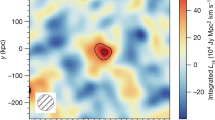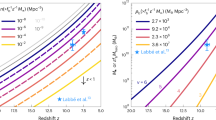Abstract
The Hubble Deep Field provides one of the deepest multiwavelength views of the distant Universe and has led to the detection of thousands of galaxies seen throughout cosmic time1. An early map of the Hubble Deep Field at a wavelength of 850 micrometres, which is sensitive to dust emission powered by star formation, revealed the brightest source in the field, dubbed HDF 850.1 (ref. 2). For more than a decade, and despite significant efforts, no counterpart was found at shorter wavelengths, and it was not possible to determine its redshift, size or mass3,4,5,6,7. Here we report a redshift of z = 5.183 for HDF 850.1, from a millimetre-wave molecular line scan. This places HDF 850.1 in a galaxy overdensity at z ≈ 5.2, corresponding to a cosmic age of only 1.1 billion years after the Big Bang. This redshift is significantly higher than earlier estimates3,4,6,8 and higher than those of most of the hundreds of submillimetre-bright galaxies identified so far. The source has a star-formation rate of 850 solar masses per year and is spatially resolved on scales of 5 kiloparsecs, with an implied dynamical mass of about 1.3 × 1011 solar masses, a significant fraction of which is present in the form of molecular gas. Despite our accurate determination of redshift and position, a counterpart emitting starlight remains elusive.
This is a preview of subscription content, access via your institution
Access options
Subscribe to this journal
Receive 51 print issues and online access
$199.00 per year
only $3.90 per issue
Buy this article
- Purchase on Springer Link
- Instant access to full article PDF
Prices may be subject to local taxes which are calculated during checkout



Similar content being viewed by others
References
Williams, R. E. et al. The Hubble Deep Field: observations, data reduction, and galaxy photometry. Astron. J. 112, 1335–1389 (1996)
Hughes, D. H. et al. A submillimetre survey of the Hubble Deep Field: unveiling dust-enshrouded star formation in the Early Universe. Nature 394, 241–247 (1998)
Downes, D. et al. Proposed identification of Hubble Deep Field submillimeter source HDF 850.1. Astron. Astrophys. 347, 809–820 (1999)
Dunlop, J. S. et al. Discovery of the galaxy counterpart of HDF 850.1, the brightest submillimetre source in the Hubble Deep Field. Mon. Not. R. Astron. Soc. 350, 769–784 (2004)
Wagg, J. et al. A broad-band spectroscopic search for CO line emission in HDF850.1: the brightest submillimetre object in the Hubble Deep Field-north. Mon. Not. R. Astron. Soc. 375, 745–752 (2007)
Cowie, L. L., Barger, A. J., Wang, W.-H. & Williams, J. P. An accurate position for HDF 850.1: the brightest submillimeter source in the Hubble Deep Field-north. Astrophys. J. 697, L122–L126 (2009)
Carilli, C. L. & Yun, M. S. The radio-to-submillimeter spectral index as a redshift indicator. Astrophys. J. 513, L13–L16 (1999)
Richards, E. A. Radio Identification of Submillimeter Sources in the Hubble Deep Field. Astrophys. J. 513, L9–L12 (1999)
Solomon, P. M. & Vanden Bout, P. A. Molecular Gas at High Redshift. Annu. Rev. Astron. Astrophys. 43, 677–725 (2005)
Walter, F. et al. A kiloparsec-scale hyper-starburst in a quasar host less than 1 gigayear after the Big Bang. Nature 457, 699–701 (2009)
Alexander, D. et al. The Chandra Deep Field North survey. XIII. 2 ms point-source catalogs. Astron. J. 126, 539–574 (2003)
Loenen, A. F. et al. Excitation of the molecular gas in the nuclear region of M 82. Astron. Astrophys. 521, L2 (2010)
Downes, D. & Solomon, P. M. Rotating nuclear rings and extreme starbursts in ultraluminous galaxies. Astrophys. J. 507, 615–654 (1998)
Tacconi, L. et al. Submillimeter galaxies at z ∼ 2: evidence for major mergers and constraints on lifetimes, IMF, and CO-H2 conversion factor. Astrophys. J. 680, 246–262 (2008)
Ivison, R. et al. Tracing the molecular gas in distant submillimetre galaxies via CO(1–0) imaging with the Expanded Very Large Array. Mon. Not. R. Astron. Soc. 412, 1913–1925 (2011)
Krumholz, M. R., Dekel, A. & McKee, C. F. A universal, local star formation law in galactic clouds, nearby galaxies, high-redshift disks, and starbursts. Astrophys. J. 745, 69 (2012)
Stacey, G. J. et al. A 158 μm [C II] line survey of galaxies at z ∼ 1–2: an indicator of star formation in the early Universe. Astrophys. J. 724, 957–974 (2010)
Barger, A. J. et al. X-ray, optical, and infrared imaging and spectral properties of the 1Ms Chandra Deep Field North sources. Astron. J. 124, 1839–1885 (2002)
Capak, P. et al. A massive protocluster of galaxies at a redshift of z ≈ 5.3. Nature 470, 233–235 (2011)
Barger, A. J., Cowie, L. L. & Wang, W.-H. A highly complete spectroscopic survey of the GOODS-N field. Astrophys. J. 689, 687–708 (2008)
Hogg, D. W., Blandford, R., Kundic, T., Fassnacht, C. D. & Malhotra, S. A candidate gravitational lens in the Hubble Deep Field. Astrophys. J. 467, L73–L75 (1996)
Riechers, D. A. et al. A massive molecular gas reservoir in the z = 5.3 submillimeter galaxy AzTEC-3. Astrophys. J. 720, L131–L136 (2010)
Daddi, E. et al. Two bright submillimeter galaxies in a z = 4.05 protocluster in Goods-North, and accurate radio-infrared photometric redshifts. Astrophys. J. 694, 1517–1538 (2009)
Schinnerer, E. et al. Molecular gas in a submillimeter galaxy at z = 4.5: evidence for a major merger at 1 billion years after the Big Bang. Astrophys. J. 689, L5–L8 (2008)
Combes, F. et al. A bright z = 5.2 lensed submillimeter galaxy in the field of Abell 773. HLSJ091828.6+514223. Astron. Astrophys. 538, L4 (2012)
Cox, P. et al. Gas and dust in a submillimeter galaxy at z = 4.24 from the Herschel atlas. Astrophys. J. 740, 63 (2011)
Ivison, R. et al. A robust sample of submillimetre galaxies: constraints on the prevalence of dusty, high-redshift starbursts. Mon. Not. R. Astron. Soc. 364, 1025–1040 (2005)
Wiklind, T. et al. A population of massive and evolved galaxies at z>∼5. Astrophys. J. 676, 781–806 (2008)
Dickinson, M. et al. The unusual infrared object HDF-N J123656.3+621322. Astrophys. J. 531, 624–634 (2000)
Daddi, E. et al. Very high gas fractions and extended gas reservoirs in z = 1.5 disk galaxies. Astrophys. J. 713, 686–707 (2010)
Acknowledgements
This work is based on observations carried out with the IRAM Plateau de Bure Interferometer. IRAM is supported by MPG (Germany), INSU/CNRS (France) and IGN (Spain). The Jansky Very Large Array of NRAO is a facility of the National Science Foundation operated under cooperative agreement by Associated Universities, Inc. D.A.R. acknowledges support from NASA through a Spitzer Space Telescope grant. R.D. acknowledges funding through DLR project FKZ 50OR1004.
Author information
Authors and Affiliations
Contributions
F.W. had the overall lead of the project. The Plateau de Bure Interferometer data were analysed by R.D., F.W., P.C., R.N., M.K. and D.D. The Jansky Very Large Array data reduction was performed by C.C., J.H. and L.L. The molecular gas excitation was led by A.W. Spectroscopic redshift information was provided by M.D., R.E., H.S., D.S. and D.P.S. The spectral energy distribution analysis, including new Herschel data, was led by E.D.C, D.E. and E.D. An updated lensing model was provided by D.D. All authors helped with the proposal, data analysis and interpretation.
Corresponding author
Ethics declarations
Competing interests
The authors declare no competing financial interests.
Supplementary information
Supplementary Information
This file contains Supplementary Text and Data 1-3, Supplementary Table 1, Supplementary Figures 1-2 and additional references. (PDF 170 kb)
Rights and permissions
About this article
Cite this article
Walter, F., Decarli, R., Carilli, C. et al. The intense starburst HDF 850.1 in a galaxy overdensity at z ≈ 5.2 in the Hubble Deep Field. Nature 486, 233–236 (2012). https://doi.org/10.1038/nature11073
Received:
Accepted:
Published:
Issue Date:
DOI: https://doi.org/10.1038/nature11073
This article is cited by
-
Normal, dust-obscured galaxies in the epoch of reionization
Nature (2021)
-
A dominant population of optically invisible massive galaxies in the early Universe
Nature (2019)
-
Optically dark massive galaxies
Nature Astronomy (2019)
-
Galaxy growth in a massive halo in the first billion years of cosmic history
Nature (2018)
-
A massive core for a cluster of galaxies at a redshift of 4.3
Nature (2018)
Comments
By submitting a comment you agree to abide by our Terms and Community Guidelines. If you find something abusive or that does not comply with our terms or guidelines please flag it as inappropriate.



